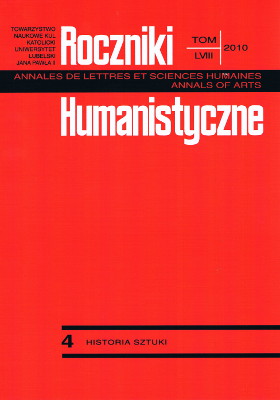Art’s Entanglement in History. And the Related Problems in Interpretation, Cognition and Evaluation: the Case of Wiktor Tołkin’s Artistic Achievements
Abstract
This paper focuses on the problem how history can influence interpretation and evaluation of a work of art. A selection of works by Wiktor Tołkin serve as the basis for case study. The first case is Tołkin's monument in the former Stutthof concentration camp. The second is the Majdanek memorial for the victims of the camp. The third case is Tołkin’s victory memorial in Darłowo and the fourth is his monument commemorating Poland’s vows at the Baltic seaside in Kołobrzeg. The last two cases are a monument of gratitude to the Soviet Army in Sztum and the bust of Janek Krasicki in Gdansk.
Wiktor Tołkin’s life and artistic work has been strongly related with the city of Gdańsk. He belongs to the generation of Poles called the Generation of Columbuses. His life is a perfect example of how one's own experiences and achievements can be determined by the unpredictable turns of history. Dramatic and life-threatening changes that Tołkin has gone through manifest themselves in his artistic achievements. The artist has created his own language of artistic expression to be able to talk about his own life experiences, but also to reflect upon society and culture in general. The author of this paper pays special attention to the process of artistic creation, with particular focus on the aspect of Tołkin’s search for suitable symbols or metaphors to help him express the message of his art in the way he planned before starting work. The paper also analyses the artistic means that Tołkin has employed, since they influence greatly the interpretation and reception of his works.
References
Bral G., Głazy wołać będą..., „Tygodnik Morski” 1968, nr 19, s. 1, 6.
Gajdziński M., 25-lecie Powrotu Ziem Zachodnich do Polski. Przekazuję heroizm tamtych dni. Rozmowa z artystą rzeźbiarzem Wiktorem Tołkinem, „Słowo Powszechne” 1970, nr 5, s. 3.
Garliński B., Po konkursie na „Łuk Wyzwolenia”, „Życie Lubelskie” 1954, nr 91, s. 4.
Grzesiuk-Olszewska I., Polska rzeźba pomnikowa w latach 1945-1995, Warszawa: Neriton 1995.
Grzesiuk-Olszewska I., W trzydziestą rocznicę Międzynarodowego Konkursu na Pomnik Ofiar Oświęcimia. Projekty niezrealizowane, „Rzeźba Polska” 1989.
Herling-Grudziński G., Podróż do Polski, „Kultura” 1991, nr 9/528.
Howorus-Czajka M., The Dynamic Process of Remembering in Art – Perception of Victor Tolkin's Historical Monuments Before and After Transformation of State System in Poland, [w:] „Current Issues in European Cultural Studies. Conference Proceedings”, red. M. Fredricksson, Linkopings: Linkoping University Electronic Press 2011.
Jacques L., The Gaze as „Object Petit a”, [w:] tenże, The Four Fundamental Concepts of Psycho-Analisis, red. J.-A. Miller, W. W. Norton & Company, New York 1978, s. 105-106.
Jaworska J., „Nie wszystek umrę…” Twórczość plastyczna Polaków w hitlerowskich więzieniach i obozach koncentracyjnych, Warszawa: Książka i Wiedza 1975.
Jaworska J., Polska sztuka walcząca 1939-1945, Warszawa: Wydawnictwo Artystyczne i Filmowe 1985.
Kitowska-Łysiak M., Ślady. Szkice o sztuce polskiej po 1945 roku, Lublin: Towarzystwo Naukowe KUL 1999, s. 59-70.
Korczak K., Pomnik. 80. urodziny Wiktora Tołkina, „Głos Wybrzeża” 2002, nr 63, s. 10.
Lachowski M., Wobec pomników zagłady, „Rzeźba Polska” 13(2008).
Lipiński Ł., Sprawa Janka Krasickiego. Obiekt architektoniczno-rzeźbiarski, „Gazeta Morska” 1998, nr 65.
Marszałek J., Majdanek. Obóz koncentracyjny w Lublinie, Warszawa: Wyd. Interpress 1987.
Olszewski A. K., Dzieje sztuki polskiej 1890-1980 w zarysie, Warszawa: Wyd. Interpress 1988, s. 70-71.
Olszewski A. K., Pomniki walki i zwycięstwa w Polsce, [w:] Pamięć wojny w sztuce, red. J. M. Michałowski, Warszawa: Ossolineum 1978.
Pamięć wojny w sztuce, red. J. M. Michałowski, Warszawa: Ossolineum 1978.
Piotrowski P., Znaczenia modernizmu. W stronę historii sztuki polskiej po 1945 roku, Poznań: Dom Wydawniczy Rebis 1999.
Sierecki S., Wybieramy gdańszczanina roku. Pamięć o przeszłości zaklęta wgłazy, „Wieczór Wybrzeża” 1968, nr 159, s. 3.
Smolarz N., Pomnik ku czci Ofiar Obozu Zagłady na Majdanku, „Architektura” 1970, nr 11, s. 382-389.
Stanisławski A., W 25-lecie wyzwolenia obozu. Pomnik Walki i Męczeństwa na Majdanku, „Dziennik Bałtycki” 1968, nr 226, s. 4.
Z wystawy projektów na Łuk Wyzwolenia w Lublinie, „Kultura i Życie” 1954, nr18, s. 3.
Copyright (c) 2010 Roczniki Humanistyczne

This work is licensed under a Creative Commons Attribution-NonCommercial-NoDerivatives 4.0 International License.





